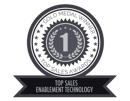sales management
What is your opportunity definition?
Let’s start with a quick experiment: select an opportunity from the early stages of your pipeline right now.
What True Story Does Your Sales Pipeline Tell You about Your Business?
Yesterday I was looking at the dashboard in my new car and noticed that one of the gauges could be swapped out. There aren't any fixed gauges on this dash because the gauges, ranges and needles are displayed digitally. I can even change their color! The thing that caught my interest though, was the flashlight effect where the ticks to either side of the needle are brighter and bolder to draw attention to where the needle is pointing.
The Ladder of Sales Competence
In psychology there’s a model called “the four stages of competence” that explains how people move through different stages when learning new competencies. I find this model interesting to have in mind when it comes to sales competence and sales technology.
Take a Look at Yourself Through Your Customer’s Eyes – If You Dare!
When was the last time you wondered what it would be like to buy from you? Maybe you never have; maybe the prospect would be far too daunting. Imagine arriving at your office, was it easy to park? Were there reserved parking spaces for customers/clients? Close to the front entrance? And when you approached reception, what response did you get? Did you feel welcomed? Valued? Important?
3 steps for successfully targeting and segmenting your customers
Success in B2B sales has little to do with individual behavior and professional selling skills. It depends on sales leaders’ ability to set the right direction and to empower the organization with the right tools. One tool is a customer segmentation and targeting model. Here are three steps to help you build a successful customer segmentation and targeting model.
CRM: Graveyards of Information or Powerhouses for Improvement?
George Brontén from Membrain has been following my posts and regularly provides insightful comments. LinkedIn is an amazing platform for building relevant connections with thought leaders around the world and we decided to catch-up on Skype.
External Exposure
Podcasts
- Tony Morris interviews George Brontén on the podcast "Confessions of a serial seller"
- Deadly Assumptions that are Killing your B2B Sales - Outside Sales Talk with George Brontén
- SaaS-Story in the Making: Designing a Buyer-focused Sales Process - with George Brontén
- Tibor Shanto, Sales Scrum, interviews George Brontén
- Andy Paul, Sales Enablement: Stop Killing Deals, with George Brontén
- Jonathan Farrington interviews George Brontén about Stop Killing Deals [the book]
- Sales Futurists: The Future of Professional Selling - What Will the New "Normal" Be Like?
- Sales Pipeline Radio: You’re Killing Sales Deals Without Knowing It: George Will Help You Fix It
- Penta Marketing Interviews George Bronten in the Podcast Emerging Stronger™
- Integrity Solutions: Unmasking and defeating deadly assumptions that plague sales organizations
Videos & interviews
- The Top 5 Ways You are Killing Your Sales - Brutal Truth Sales Podcast
- Phil Gerbyshak interviews George Brontén about the Stop Killing Deals book release
- Membrain's Founding Story
- Sales Tools - the Good, the Bad, and the Ugly
- Here's what to consider when adding or switching your CRM
- Productivity, efficiency, effectiveness – what’s what and where to focus?
- How to Build a Sales Process That Drives Successful Behaviors
- Can Checklists Stop Deals from Dying and Help Consistently Achieve Quota?
Guest Posts
- G2Crowd: "How to Get the Most out of Your Sales Technology Investment"
- Saleslounge: Varför dina stjärnsäljare blir dåliga säljchefer
- Saleslounge: Vad är komplex försäljning?
- Vainu: Så blir du en mästare på komplex B2B-försäljning
- CSO Insights: Sales Process Interview, Part 2
- CSO Insights: Sales Process Interview, Part 1
- Richardson: 3 Pitfalls that Still Make Sales Teams Waste Time and Lower Sales Effectiveness
- Smart Selling Tools: How to Stop Fighting the Monster of Sales Technology Complexity









